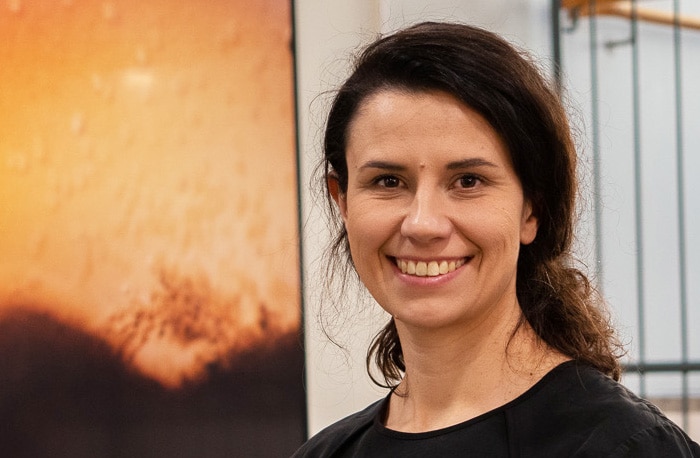Columbia Biomedical Engineering Department, the Irving Institute for Cancer Dynamics, and the New York Genome Center welcome new faculty member, Sanja Vicković, PhD.
Dr. Sanja Vicković’s path to cancer research was not a traditional one. Born and raised in Croatia, a professional ice hockey career brought her from Zagreb to Stockholm. She was part of the Croatian National Team Women’s Ice Hockey from 2005 to 2012. She became World Champions in 2007 and Swedish Elite Champions in 2011. However, it was a win for science as she joined an experimental genomics lab at the Royal Institute of Technology (Stockholm, Sweden), focusing on technology development. She hasn’t looked back since.
Dr. Vicković obtained a BSc in bioengineering from the University of Zagreb, a MSc in Molecular Biotechnology followed by a PhD in Genetics at the Royal Institute of Technology. Following her graduate work, she joined the Broad Institute of MIT and Harvard as a Wallenberg Fellow. The Wallenberg Fellowship provides recent PhD graduates in Sweden with an opportunity to pursue their independent research to build the foundation of their lab. She joins Columbia University on July 1st as an assistant professor of biomedical engineering (in the Herbert and Florence Irving Institute for Cancer Dynamics). She also will have an appointment at the New York Genome Center (NYGC) as a Core Faculty and the Director of the Technology Innovation Lab.
In her lab, she will focus on developing accessible genomic methods for use in clinics. Currently, sporadic causes, progression mechanisms, or the influence of environmental factors responsible for increasing cancer occurrences are poorly understood. While mutational signatures lead to positive selection and growth stimulation during cancer formation, we need to correlate this burden to mechanisms of cancer progression, including chronic inflammation. These aberrant cell programs need to be triggered by complex host-environment interactions. “In my group, I want to bridge the gap in studying these cell-to-cell responses by developing novel genomics, molecular and deep learning tools for characterizing the spatial tissue environment. I strongly believe these approaches will improve our molecular and histological understanding of the inter-and intra-cellular wiring of tissue interactions and the environment needed for signaling during disease progression,” Dr. Vicković explains.
Dr. Vicković has pioneered novel spatially resolved transcriptomics and genomics methods that enable massive parallel in situ profiling of intact tissue samples. She co-developed a spatial transcriptomic technology called “Visium,” which is now commercialized by 10X Genomics, a biotech company specializing in gene sequencing technology. The desire to transform the field of pathology and introduce genomics concepts that directly link tissue histology to gene expression and function is what initially inspired her interest in the spatial genomics field.

Dr. Vicković was drawn to Columbia University because of its robust biomedical engineering program. “Columbia has developed one of the strongest bioengineering programs in the country and has a fantastic track record of collaborating within and across different NYC institutions. This is an important virtue of any engineering school as we need to be able to translate our methods and machinery into clinical applications fast,” says Dr. Vicković. Additionally, joining the Irving Institute for Cancer Dynamics (IICD) seemed like a natural choice because of her background in mathematics and her research related to cancer. Researchers from IICD are from various departments of the University, facilitating collaboration across multiple fields to carry out interdisciplinary research.
“Being part of IICD allows me to continue focusing on interdisciplinary research and connecting interests in combining novel analysis approaches in real-time as we develop new technologies. Additionally, it is wonderful to be able to easily connect to the large cancer network in the NYC area through IICD. There are always so many opportunities around and having access to patient data we use in our data science program is amazing,” Dr. Vicković explains. “We are delighted to have Dr. Sanja Vicković joining the Institute. Her expertise in spatial genomics and transcriptomics will be a great addition to our IICD team and our commitment to technology development,” says Dr. Simon Tavaré, Professor of Statistics and Biological Sciences, and Director of the Irving Institute for Cancer Dynamics.
At NYGC, Dr. Vicković will direct the Technology Innovation Lab, which explores completely novel concepts in genomics, biophysics, and chemistry to develop tools for characterizing the missing ‘biological’ measurements and space which cannot be addressed with current methods. “An important aspect we are currently discussing is the concept of causality in biology. We are moving away from only profiling cells to being able to perturb and predict the behavior of complex biological systems,” Dr. Vicković adds. She is no stranger to NYGC, as she has previously worked with NYGC Faculty members Hemali Phatnani and Silas Maniatis. In collaboration with NYU Faculty member Richard Bonneau, they generated the most extensive histo-molecular profile of any neurodegenerative disease to date. “It was such a beautiful scientific collaboration that I had to join NYGC to continue asking the tough biological questions,” she explains.
Dr. Vicković’s dedication and drive as an athlete are traits she brings to her career in cancer research. She looks forward to being part of multiple departments and institutions across Columbia University and the NYGC, “allowing more exposure to the diversity science has to offer. I trained in three different fields, and I love interacting with students and peers. I also think the departments welcomed me with open arms despite not being the traditional faculty candidate. It says a lot about the opportunities that Columbia University and NYGC have to offer to perform cutting-edge science,” she concludes.
